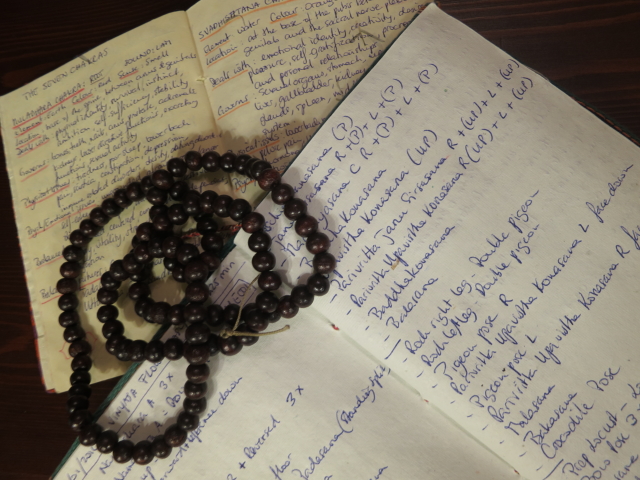With just under 300 taught yoga classes logged over the past six months, I hardly qualify as an experienced teacher.
But that’s exactly why I want to share my experiences now.
I know that in a while, I will have forgotten the mistakes I made and the brilliant “ah-ha moments” that lit up my path along the way. I’m afraid that I will not remember how it once was to not know or to not be able to do something and that I’ll be taking my experience and knowledge for granted.
So now, before it’s too late, before I forget: this is how I learned to (un)prepare my yoga classes.
The first lesson I taught—a Vinayasa class for four girlfriends in a living room—took me more than three hours to prepare. Three hours!
I choreographed, researched, practiced, rehearsed, memorized, prepared a playlist but then decided against using music after all, rearranged the furniture in the living room, placed the mats and hoped with all ten toes and fingers crossed that everything would go as planned.
After the first sun salutation I forgot my carefully prepared sequence. I started improvising. Somewhere, somehow, I got back on track but we had to stop halfway the class to re-position some mats in order to avoid nose-in-bum situations. I cut out some asanas towards the end because I was going well over the planned 90 minutes. And during savasana I sat there, silently giggling at myself for having gotten them through it without any incidents.
A three hour prep for a one and a half hour class. Hardly a profitable business case.
But my friends said it was great. And that’s what friend are for: giving compliments and being guinea pigs.
So I kept going. I prepared carefully, looking up new poses in books, finding inspiration online, reading up on therapeutic applications of specific asanas so I would have something interesting to say during Yin or Restorative Yoga, practicing each sequence over and over again.
By now, almost 300 lessons down the line and teaching 20 classes a week in a little resort town in the desert in Egypt, I have drastically reduced my preparation time, only taking more time for special cases such as a lady with fibro myalgia, a friend with coronary problems or my first kids yoga class.
A big improvement, time-wise I would say. I don’t use my notebook anymore and most of my classes are improvised.
Well, not completely improvised of course. However, in my modest experience of the past six months, I noticed that during my classes, I was always changing what I had prepared because something unpredictable inevitably happened.
Sometimes the energy among the group was so low that I needed to tone down the practice. Sometimes everybody was so active and jumpy that I added some extra challenges halfway. Sometimes none of the beginners showed up and I was able to spice it up for the advanced. Sometimes my students would collectively agree that they didn’t want to do a Vinyasa class and asked for Yin instead.
In all of the above cases, out went my meticulously prepared sequence and in came my improvisation skills.
I realise now that I needed to go through this process of detailed preparation. I simply am that kind of person. When I’m new to something, I need to understand every single detail, I need to organise my mind in order to feel in control. Once I feel what I’m doing, once it has become like a second skin and the new skill is engrained in my body and soul, then I can let go of the reins and go with the flow.
That’s how, gradually, I learned to un-prepare my yoga classes.
Now, I simply set an intention or a theme for each class, such as “hip openers”, “chakras”, “smile”, “strength” or whatever suits the day. Sometimes I have a matching quote, sometimes I ask them to formulate their own Sankalpa.
Today for instance, with the supermoon, I knew I had to be careful in managing my students’ energy. So before I started my Vinyasa class in the morning, I knew I was going to make it a non-stop flow. No stationary asanas, but gentle yang movements, up and down, left and right, rounding and arching, breathing slowly and deeply. Not too intense, not too rigid, but rolling, like the waves of the ocean. From my collection of favourite quotes, I picked one about the moon and I built my class around it.
“The moon does not fight. It attacks no one. It does not worry. It does not try to crush others. It keeps to its course, but by its very nature, it gently influences. What other body could pull an entire ocean from shore to shore? The moon is faithful to its nature and its power is never diminished.”
~ Deng Ming-Dao, Everyday Tao: Living with Balance and Harmony
Another example is from a few months ago, when it rained for three days in a row—which is quite a rare phenomenon here in the desert in Egypt. During class, I spoke about the refreshing rain and focussed on Svadhistana Chakra, on hip openers and everything that is water. I started the class with the following quote:
“Water does not resist. Water flows. When you plunge your hand into it, all you feel is a caress. Water is not a solid wall, it will not stop you. But water always goes where it wants to go, and nothing in the end can stand against it. Water is patient. Dripping water wears away a stone. Remember that, my child. Remember you are half water. If you can’t go through an obstacle, go around it. Water does.”
~ Margaret Atwood, The Penelopiad
That is the preparation I allow myself for my regular classes.
I let go of this obsessive need for sense of control prior to the class. I stopped taking overly detailed notes in my notebook. I don’t repetitively practice the sequence anymore in order to memorise the flow.
Only once the students are on their mat and I have assessed their level of practice, their (previous) injuries, their overall state of mind and the kind of energy present in the room, do the asanas come together in my head and do we start to move with the breath.
My intention is set and fixed from the beginning. But in the execution, I’m flexible and I go with the flow.
As Bruce Lee wrote in the Tao of Jeet Kune Do:
“Not being tense but ready.
Not thinking but not dreaming.
Not being set but flexible.
Liberation from the uneasy sense of confinement.
It is being wholly and quietly alive, aware and alert, ready for whatever may come.”
Love elephant and want to go steady?
Sign up for our (curated) daily and weekly newsletters!
Editor: Catherine Monkman
Photo: Author’s own.

 Share on bsky
Share on bsky



Read 0 comments and reply